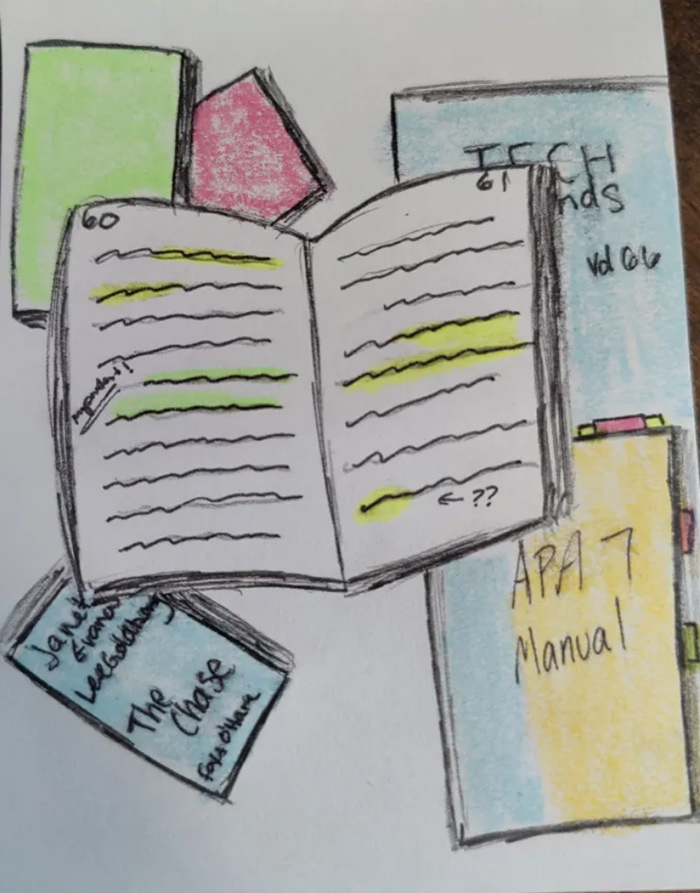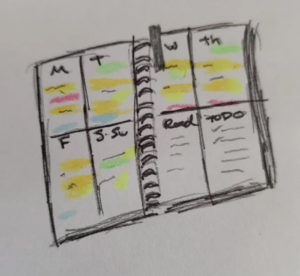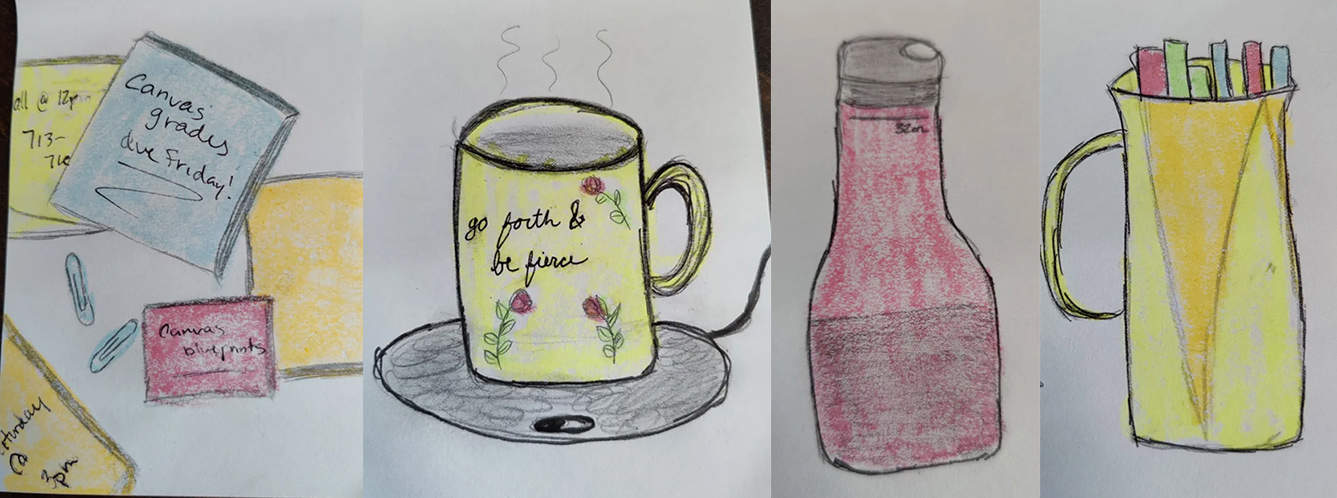When I was growing up back in small-town Ohio, I lived next to a pair of sisters who were some of my closest friends for years. Both sisters were (and still are) incredibly artistically talented. They had sketchbooks and always created the most amazing drawings. One even did the artwork for my first tattoo. I had (and still have) zero artistic ability or talent. I used to doodle little two-dimensional TARDISes in the margins of my math assignments, and that was as far as my ability to draw ever took me. While my friends drew in their sketchpads, I was writing stories in my notebooks.
Several of my explorations so far have stuck very closely to my strengths with writing and reading and books. This week, I’ve chosen to push myself outside of my comfort zone, away from creativity with words and into creativity in drawing.
Exploration #26: Becoming Leonard Cohen

I chose this exploration from How to Be an Explorer of the World by Keri Smith to purposefully push myself away from areas where I’m most comfortable and into something that doesn’t come as easily to me. The whole point of exploring the world isn’t to explore my comfort zone, right?
This exploration asks the explorer to “sketch or document things that you use in your daily routine.” I could’ve interpreted the “document” option into creating another fun graphic with Canva, but since I’m really trying to push myself, I decided to stick to the “sketch” option.
Lesson #1: Push yourself out of your comfort zone.
I made several careful choices about the media I wanted to use. First, I dug through all of my notebooks and notepads looking for something that was unlined. Like I said, I’m a words person, so I might have a million piles of little notebooks, but they’re all lined. Finally, I found an AECT notepad from the convention in Chicago this past November in my leather workbag. Then I decided that my inability to draw well meant that I needed to start my sketches with pencil so I could erase my mistakes (I feel like there’s a metaphor to be had here, but I’m too tired to figure it out). In my forays into graphic design, I’m always drawn to simplistic cartoon drawings with splashes of color, so I decided to limit my color choices to the pack of gel highlighters that I use in my research. Besides, these explorations are an attempt to understand myself as a researcher, so that felt appropriately symbolic. Finally, I used a single black flair pen to add some weight to some of the pencil lines.
I chose to be purposefully messy in my sketches for two reasons. The first is that I enjoy the art style where the color is slightly misaligned to the shapes in the images. The second is that I figured my sketches would end up a little messy anyway, so why not do it on purpose and avoid my perfectionist frustration?

Lesson #2: Be purposeful in choice of media.
Data Collection
Then I needed to decide what to draw. The exploration says, “things that you use in your daily routine.” There are so many things that I use in my daily routine, so I considered which ones were most important to me on an emotional level. My computer, keyboard, and mouse are probably at the top of the list of things that I couldn’t live without for work and school, and while I do adore my computer, it just didn’t strike me as something that I wanted to document.
In the end, I chose six items to document:
Post-it notes and paperclips are something that are always scattered around my desk area; I’m constantly jotting down little notes and reminders for myself, often somewhat chaotically. I added some examples of those messages to the pads of Post-it notes in my drawing, though really the notes usually end up stuck around the computer monitor or on my desk…or sometimes on the floor when one of the cats goes on a destructive run across my desk.
 Books are (obviously) my passion, and I’m always surrounded by them. I chose to keep some books in my drawing generic, but I did specifically depict my APA manual, the issue of TechTrends currently sitting on my desk, and the Janet Evanovich and Lee Goldberg series that is my current fiction obsession. I sketched one book open with highlights and notes to show how I’m always using these books in my work, but I included the Janet Evanovich novel to emphasize my continuous attempt to hold on to my nonacademic reading.
Books are (obviously) my passion, and I’m always surrounded by them. I chose to keep some books in my drawing generic, but I did specifically depict my APA manual, the issue of TechTrends currently sitting on my desk, and the Janet Evanovich and Lee Goldberg series that is my current fiction obsession. I sketched one book open with highlights and notes to show how I’m always using these books in my work, but I included the Janet Evanovich novel to emphasize my continuous attempt to hold on to my nonacademic reading.
 My planner is like a bible to me, and I tried to show the color-coding system that I use to keep all of the aspects of my life organized. Each item listed on each day in my planner is highlighted in a color that corresponds to a different aspect of my life: HCC, UH, homework, personal, etc. I liked how that color-coding is the only color in the sketch.
My planner is like a bible to me, and I tried to show the color-coding system that I use to keep all of the aspects of my life organized. Each item listed on each day in my planner is highlighted in a color that corresponds to a different aspect of my life: HCC, UH, homework, personal, etc. I liked how that color-coding is the only color in the sketch.
I have several coffee cups that I rotate through each week, but I chose to (attempt to) draw one that was a parting gift from a good friend when I left the classroom. The words “go forth and be fierce” surrounded by flowers have become a mantra that helps me get through the tough days. I even included the Mr. Coffee warmer, where each coffee cup rests every morning.
In addition to my morning cup of coffee, I always have my water bottle on my desk with me. My coworkers and I are constantly reminding each other to stay hydrated; in fact, our unofficial motto is “Hydrated & Unbothered.”
The last item I sketched was the yellow and orange ceramic cup that I made at a pottery painting place in 2014 at the start of my teaching career. I wrote in terrible cursive on one side “Free Pencils” as my optimistic self believed I would always have pencils on my desk for my students. I wrote about this topic several years ago, so I’ll restrain myself from rambling about it now. These days, this cup holds not pencils but the flair pens and highlighters that I use in my carefully color-coded organization system.

For reference, I took photos of some of the items that I drew.

Lesson #3: Be purposeful in choice of data.
Data Analysis
While I was creating my sketches, or collecting my data, I focused mostly on the act of drawing. I tried to remember what I’d learned in my high school art class about perspectives and drawing in three-dimensions. I also thought about a drawing lesson that a group of students designed and delivered in my EdTech class last semester (side note: that lesson was the coolest use of Pear Deck I’ve ever seen).
It wasn’t until I started writing the descriptions of each item for this blog that I started to really think about the items that I chose. Half of the items are forms of vessels: a coffee cup, a pencil cup, a water bottle. The other half are paper-based and either things that I read, write on, or both: the Post-it notes, the planner, the pile of books. What does this say about me? Did I choose items in those two categories in a simple domino effect? I drew the coffee cup, which made me think of the water bottle, which made me think of the pencil cup. Or does this reveal something about me? If so, what?
I had superficial reasons for choosing some items. I chose the Post-it notes because I figured those would be simple to draw and a good item to get my exploration started. Other choices feel more meaningful. I chose the planner because it is the glue that holds my life together. If I had kept going, what other items might I have chosen and for what reasons? If I had more self-efficacy in my ability to draw, what items might I have chosen? Would my reasoning have changed if I’d felt more capable of drawing complex items?
Lesson #4: Pay attention to the reasoning behind choices made.
I don’t necessarily know the answers to these questions right now. If I spent more time digging into this small dataset and reading literature and theory that could help to explain my choices, I could probably discover some interesting things about myself.
Then again, maybe there’s a good reason I never followed through on my psychology second major back in my undergrad years, and I should probably just leave myself un-analyzed.

In this exploration, I pushed myself outside of my comfort zone by attempting to draw. In research, it’s important to take purposeful steps out of your comfort zone.
Choose a topic that you don’t know, something that you’ve never explored before, something completely new. Explore the topic through Credo Reference, either by typing it into the search or finding it on the extensive list of topics. How far do you need to explore before you find something that sparks your curiosity? How many connections can you find to topics that you do know? The only way to expand your horizons is to step outside of what you know.
Learn more about Credo Reference for colleges and universities and public libraries, and take a FREE TRIAL today!
Originally published on Mrs. Hebert’s Classroom on March 13, 2022. You can also listen to the podcast here:
Like this article? Check out the previous blog articles in this series:
- Learning to Be an Explorer of the World
- Exploring the World in Words
- Exploring Pointillism in My Backyard
- Exploring the Farmers Market
Also, check out the next blog articles in this series:
See also:



